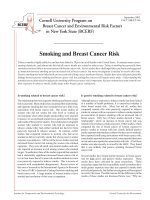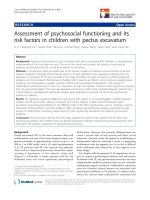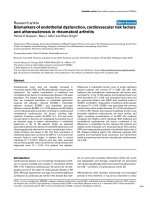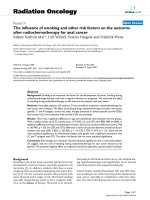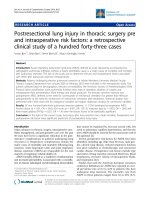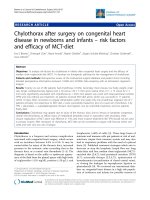Prevalence of obesity and associated risk factors in chinese pre school children aged 6 to 72 months old in singapore 3
Bạn đang xem bản rút gọn của tài liệu. Xem và tải ngay bản đầy đủ của tài liệu tại đây (1.66 MB, 60 trang )
CHAPTER 3
3. RESULTS
3.1 Characteristics of the study population
Table 3 shows the anthropometric and demographic characteristics of the
participants. Boys were heavier, taller and had higher BMI than girls. Fathers who
had university (and above) education constituted 33.0% and the percentage of
mothers with university education (and above) was 28.0%. About half of the
families (45.2%) had total combined monthly income of ≥S$ 5,000.
Table 4 shows birth weight and behavioral characteristics of the
participants. The mean time spent in total on sedentary activities was about five
times greater than that of total outdoors activities [3.4±2.5(SD) vs. 0.7±0.9(SD)
hours per day, p=<0.001]. Among sedentary activities, watching television time
was longer than time spent on computer/ handheld video games [1.9±1.5(SD) vs.
0.3±0.8(SD) hours per day, p=<0.001] and reading, drawing, coloring time
[1.9±1.5(SD) vs. 1.2±1.3(SD) hours per day, p=< 0.001].
Majority of mothers (77.8%) breastfed their children and the most
common type of breastfeeding was partial breastfeeding (77.6% with 1 to 6
months breastfeeding and 60.2% with 6 to 12 months breastfeeding).
58
Table 1. Anthropometric and demographic characteristics of the participants
Gender
All
n (%)
2964(100.0)
Boys
n (%)
1548(52.2)
Girls
n (%)
1416(47.8)
<0.001
Weight (kg)
Mean (SD)
14.8(4.3)
15.2(4.3)
14.5(4.2)
Height (cm)
Mean (SD)
96.0(13.2)
96.6(13.1)
95.4(13.2)
0.01
Body Mass Index (BMI) (kg/m2)
Mean (SD)
15.9(2.0)
16.0(1.9)
15.7(2.0)
Age groups (months)
6.0–11.9
12.0–23.9
24.0–35.9
36.0–47.9
48.0–-59.9
60.0–72.0
181(6.1)
527(17.8)
509(17.2)
571(19.3)
601(20.3)
575(19.4)
85(5.5)
304(19.6)
257(16.6)
291(18.8)
321(20.7)
290(18.7)
96(6.8)
223(15.7)
252(17.8)
280(19.8)
280(19.8)
285(20.1)
Father’s education
None/Primary
Secondary/ ‘O’/ ‘N’ level
‘A’ level/ Polytechnic/ Diploma/ ITE/
Certificate
University (degree and above)
291(10.0)
856(29.5)
794(27.4)
156(10.3)
437(28.9)
432(28.6)
135(9.7)
419(30.3)
362(26.1)
957(33.0)
488(32.3)
469(33.9)
Mother’s education
None/Primary
Secondary/ ‘O’/ ‘N’ level
‘A’ level/ Polytechnic/ Diploma/ ITE/
Certificate
University (degree and above)
199(6.8)
1032(35.4)
869(29.8)
106(7.0)
543(35.6)
456(29.9)
93(6.7)
489(35.1)
413(29.6)
818(28.0)
419(27.5)
399(28.6)
73(2.5)
622(21.6)
887(30.7)
1303(45.2)
39(2.6)
311(20.7)
480(31.9)
676(44.9)
34(2.5)
311(22.6)
407(29.5)
627(45.5)
Total combined monthly income
< S$ 1,000
S$ 1,000 – S$ 2,999
S$ 3,000 – S$ 4,999
≥ S$ 5,000
p-value*
<0.001
0.07
0.42
0.92
0.35
*: p-value based on chi-square (categorical) and independent sample t-test (continuous).
59
Table 2. Birth weight and behavioral characteristics of the participants
n (%)
Birth weight (grams)
All
Mean (SD)
3089.6
(458.8)
n (%)
Boys
Mean (SD)
3137.8
(466.0)
Girls
Mean (SD)
3036.7
(444.9)
n (%)
Preschool hours (hour/day)
5.3(3.2)
5.6(3.2)
5.1(3.2)
Playing outdoors (hour/day)
0.6(0.7)
0.6(0.7)
0.5(0.7)
Outdoor leisure activities
(hour/day)
0.2(0.5)
0.2(0.4)
0.2(0.5)
Total outdoors time
(hour/day)
0.7(0.9)
0.7(0.9)
0.7(1.0)
Watching television
(hour/day)
1.9(1.5)
1.9(1.5)
1.9(1.5)
Playing computer/ television/
hand held video games
(hour/day)
0.3(0.8)
0.4(1.0)
0.2(0.5)
Reading, drawing and
coloring activities (hour/day)
1.2(1.3)
1.1(1.2)
1.3(1.3)
Total sedentary activities
(hour/day)
3.4(2.5)
3.4(2.6)
3.4(2.4)
Presence of park or garden
near home
Yes
2063(69.8)
1088(70.4)
975(69.1)
Breastfeeding
Yes
2296(77.8)
1186(77.0)
1110(78.7)
Breastfeeding (1 to 6 months)
Exclusive breastfeeding
Mostly breastfeeding
Partly breastfeeding
180(17.7)
48(4.7)
790(77.6)
86(16.5)
21(4.0)
413(79.3)
94(18.8)
27(5.4)
377(75.6)
Breastfeeding (6 to 12
months)
Exclusive breastfeeding
Mostly breastfeeding
Partly breastfeeding
104(31.8)
26(8.0)
197(60.2)
58(31.4)
15(8.1)
112(60.5)
46(32.4)
11(7.7)
85(59.9)
60
3.2 Participants and Non-participants
Table 5 shows the comparison between participants and non-participants.
The participants were mostly from the Jurong West area (42.5%) and the
participation of boys (52.2%) was slightly more than that of girls (47.8%).
However, the numbers of participants from different age groups were similar
except for the 6–11.9 months age group.
Table 6 highlights age differences between participants and nonparticipants. The mean age of participants and non-participants were similar
(40.48 vs. 39.78 months) with standard deviations of 18.57 and 18.48
respectively. There was no significant difference in ages between participants and
non-participants.
61
Table 3. Comparison between participants and non-participants
Non-Participants
(n=1,155)
n
%
AREA
N
Participants
(n=3,009)
n
%
Percent
Bukit Batok
Clementi
Jurong East
Jurong West
NO INFO
others
South Central
174
121
103
415
3
3
336
15.1%
10.5%
8.9%
35.9%
0.3%
0.3%
29.1%
408
209
366
1,279
17
36
694
13.6%
6.9%
12.2%
42.5%
0.6%
1.2%
23.1%
boy
girl
227
199
53.3%
46.7%
1,570
1,439
52.2%
47.8%
p
<0.001
gender
0.668
Valid
Missing
Age
Group
6–11.9
12–23.9
24–35.9
36–47.9
48–59.9
60–72
426
729
19.7%
80.3%
62
5.9%
190
6.3%
193
183
194
204
207
18.5%
17.5%
18.6%
19.6%
19.8%
540
516
579
605
579
17.9%
17.1%
19.2%
20.1%
19.2%
0.977
Valid
Missing
1043
112
90.3%
9.7%
Table 4. Age difference between participants and non-participants
Participation
N
Mean
S.D.
Median Range Skewness
Kurtosis
No
1,043
39.78
18.48
40.00
66.00
-0.05
-1.19
Yes
3,009
40.48
18.57
41.20
65.92
-0.07
-1.14
P
0.289
62
3.3 Distributions of Height, Weight, Body Mass Index and
Skinfold Measurements
3.3.1 Distributions of Height (centimeters)
Among the 3,009 participated children of aged 6–72 months old, 2,964
children (98.5%) were involved in the analysis of distributions of height, weight
and body mass index.
Figure 1 shows the distributions of height according to different age
groups. It shows that height was normally distributed among different age groups
(kurtosis=0.25 to 3.84 and skewness=-0.49 to 0.29). It also highlighted that there
were significant differences in height (mean) among different age groups
(p=<0.001).
Figure 2 shows the distributions of height according to different age
groups for boys. The results were normally distributed except for the 36.0–47.9
months age group (kurtosis=1.50, skewness=-0.46 to 0.66). Significant
differences in height (mean) were also seen between the different age groups
(p=<0.001).
Figure 3 highlights the distributions of height according to different age
groups for girls. Although they had kurtosis of 4.36, 1.24, 3.54 and 6.00 for age
groups of 6-–11.9, 12–23.9, 24–35.9 and 60–72 months, respectively, the
distributions were normal.
63
There was a significant difference in height (mean) between boys and girls
(p=0.01) and as the age increased, the mean value of height also increased, as
seen in all these figures.
64
Figure 1. Distribution of Height (centimeters) by age groups
65
Figure 2. Distribution of Height (centimeters) of boys by age groups
66
Figure 3. Distribution of Height (centimeters) of girls by age groups
67
3.3.2 Distributions of Weight (kilograms)
Figure 4 demonstrates the distributions of weight according to different
age groups. The weight of age groups 6–11.9 and 12–23.9 months were normally
distributed (p=0.76 and p=0.41, respectively), but the distributions of the other
age groups were skewed towards higher values (skewness ranged from 0.66 to
1.97) and they had kurtosis which ranged from 1.70 to 9.39.
The distributions of weight according to different age groups for boys are
shown in Figure 5. Among six age groups, three age groups (6.0–11.9, 12.0–23.9
and 24.0–35.9 months) showed a normal distribution (p=0.43, p=0.90 and p=0.41,
respectively). However, the distributions of the other three age groups (36–47.9,
48–59.9, 60–72 months) were skewed towards higher values of 1.71, 1.63 and
1.21 and kurtosis of 5.19, 6.15 and 2.09 respectively.
As shown in Figure 6, similarly skewed distributions towards higher
values were also seen in girls of the same age groups (36–47.9, 48–59.9, 60–72
months) with the skewness of 2.29, 1.62 and 2.35 and kurtosis of 15.53, 5.27 and
13.72, respectively. On the other hand, the age groups of 6–11.9, 12–23.9 and 24–
35.9 months showed normal distribution (p=0.54, p=0.60 and p=0.12,
respectively).
Similarly, significant differences of weight (mean) were found between
boys and girls with p-value of <0.001 and as in height, the mean value of weight
increased as the age increased.
68
Figure 4. Distribution of Weight (kilograms) by age groups
69
Figure 5. Distribution of Weight (kilograms) of boys by age groups
70
Figure 6. Distribution of Weight (kilograms) of girls by age groups
71
3.3.3 Distributions of Body Mass Index (BMI)
The distributions of BMI according to different age groups for both
genders are shown in Figure 7. Only the 12.0–23.9 months age group
demonstrated that BMI was normally distributed (p=0.20). The other age groups
showed distributions with skewness towards higher values (skewness ranged from
0.53 to 3.35 and kurtosis ranged from 4.28 to 28.35).
In addition, as seen in Figure 8, the distributions skewed towards higher
values for age groups 6.0–11.9, 36.0–47.9, 48.0–59.9 and 60.0–72 months in boys,
with skewness ranging from 1.24 to 2.5 and kurtosis from 2.50 to 7.77.
Nevertheless, two age groups (12.0–23.9 and 24.0–35.9 months) described the
normal distribution pattern with p-value 0.73 and 0.15, respectively.
According to Figure 9, girls of all age groups in our study showed
distributions of skewness towards higher values with skewness ranging from 1.14
to 4.61 and kurtosis from 2.41 to 46.33.
Overall, the majority of the distributions of BMI skewed towards higher
values for both genders except from only two age groups (12.0–23.9 and 24.0–
35.9 months of boys). Moreover, significant difference in distributions of BMI
(mean) between boys and girls (p=<0.001) was also found.
72
Figure 7. Distributions of BMI by age groups
73
Figure 8. Distribution of BMI of boys by age groups
74
Figure 9. Distribution of BMI of girls by age groups
75
3.3.4 Distributions of Skinfold (Triceps) Measurements
1,176 children were 48 months or older. However, only 923 of these
children (78.5%) were involved in the analysis of distributions of skinfold
(Triceps) measurements due to missing values.
Figure 10 shows the distributions of skinfold (Triceps) measurements
according to different age groups for all children (n=923). Both the distributions
of the 48.0–59.9 and 60.0–72.0 months age groups were skewed towards higher
values (skewness=0.95, 1.25 and kurtosis=1.31, 1.86, respectively). In addition,
there was no significant difference of mean skinfold measurements between these
two age groups (p=0.11).
In Figure 11, the distributions of skinfold measurements for boys, also
shows that all distributions were not normal. The distributions of boys, skewness
ranged from 1.03 to 1.21 and kurtosis ranged from 1.03 to 1.52. Moreover, there
was no significant differences of mean skinfold measurements between different
age groups (p=0.90).
Similarly, Figure 12 shows distributions of skinfold measurements of girls
by different age groups which were skewed towards higher values, ranging from
0.96 to 1.37 and had kurtosis ranged from 1.51 to 2.73. Mean skinfold
measurements were not significantly varied between different age groups
(p=0.72).
76
As found in height, weight and BMI distributions, there was a significant
difference in skinfold measurements between boys and girls (p=<0.001).
Figure 10. Distribution of Skinfold (Triceps) measurements by age groups
77
Figure 11. Distribution of Skinfold (Triceps) measurements of boys by age groups
Figure 12. Distribution of Skinfold (Triceps) measurements of girls by age groups
78
3.4 Prevalence of overweight and obesity according to different
definitions
Only children aged 2–5 years (1,159 boys and 1,097 girls) were involved
in the analysis of prevalence of overweight and obesity. This is because the “CDC
and IOTF BMI for age” definitions define the cutoffs from 2 to 20 years.
However, using the “Singapore BMI for age” reference which defines cutoffs of
overweight and obesity in children starting from birth to 72 months, 1,548 boys
and 1,416 girls were involved in the analysis.
Table 7 shows the prevalence of overweight and obesity according to age
groups by the three references: the “CDC BMI for age”, “IOTF BMI for age” and
“Singapore BMI for age” references. Prevalence of obesity increased with age (ptrend=<0.001) by the “CDC BMI for age” and the “IOTF BMI for age”
references. However, the age effect on obesity by the “Singapore BMI for age”
reference was not seen.
Table 8 demonstrates the prevalence of overweight and obesity by gender
and age groups according to the “CDC, IOTF and Singapore BMI for age”
references. For boys, age did not effect on the prevalence of overweight by all
three references while the prevalence of overweight increased with age for girls
(p-trend=0.01 for both “CDC and IOTF BMI for age” references). Similarly, the
increasing trend in the prevalence of obesity with age was seen in both genders by
the “CDC and IOTF BMI for age” references (p-trend=<0.001 [boys] and 0.002
[girls] for the “CDC BMI for age” reference, p-trend=0.002 [boys] and 0.01
79
[girls] for the “IOTF BMI for age” reference), but the trend was not found by the
“Singapore BMI for age” reference.
3.4.1 Prevalence according to “CDC BMI for age” reference
As shown in Table 7, the overall prevalence of overweight was 8.1% and
that of obesity was 7.1%. The percentage of boys who were obese was a little bit
higher than that of boys who were overweight (8.3% vs. 7.3%) with p-value of
0.02 (Table 8). In contrast, the percentage of girls who were overweight was
about two times higher than that of girls who were obese (9.0% vs. 5.7%, p=0.03)
(Table 8). The result also showed that boys were more likely to be obese than
girls (OR=1.42, 95% CI: 1.02,1.97, p=0.03) whereas there was no statistically
significant gender difference for the prevalence of overweight (p=0.10).
Furthermore, for both genders, the prevalence of obesity increased with age
(p=<0.001 for boys and p=0.002 for girls). However, the increasing prevalence of
overweight with age was seen in girls only (p=0.01) and not in boys.
3.4.2 Prevalence according to “IOTF BMI for age” reference
According to the “IOTF BMI for age” cutoffs (Table 7), the overall
prevalence of overweight was 7.6% and that of obesity was 3.9%. The prevalence
of overweight (boys=6.8%, girls=8.4%) was higher than that of obesity
(boys=4.6%, girls=3.2%) for both genders although it was not statistically
80
significant (p=0.09 for boys and p=0.11 for girls) (Table 8). There were also no
statistically significant difference in the prevalence of overweight (p=0.10) and
obesity (p=0.13) between genders (Table 8). The increasing trend of prevalence of
obesity with age was seen in both genders (p=0.002 for boys and p=0.01 for girls)
although the age effect on overweight was only seen for girls (p=0.01).
3.4.3 Prevalence according to “Singapore BMI for age” reference
Table 7 also shows the prevalence of overweight and obesity according to
the “Singapore BMI for age” cutoffs. The overall prevalence of overweight was
7.0% and for obesity was 5.3%. As shown in Table 8, the prevalence of obesity
for boys and girls were similar (5.4% and 5.3%, respectively). There were no
statistically significant differences in the prevalence of overweight (p=0.39) and
obesity (p=0.94) between genders. However, for both genders, overweight
prevalence (boys=7.4%, girls=6.6%) was higher than that of obesity (boys=5.4%,
girls=5.3%) and that was statistically significant with p-value for boys was
0.01and that for girls was 0.02. Trend between prevalence and age was not found
in our study, using the “Singapore BMI for age” reference.
3.4.4 Comparison of prevalence according to different definitions
Figure 13 shows the comparison of overall overweight and obesity
prevalence for boys and girls with the three different references (the “CDC, IOTF
81
and Singapore BMI for age” references). To allow for a comparison of the three
different references, the prevalence, using the “Singapore BMI for age” reference,
only involved children who were 24 months and older.
As shown in Figure 13, there were more obese boys than girls. However,
overweight was common in girls than in boys, based on the “CDC BMI for age”
and the “IOTF BMI for age” references. Using the “Singapore BMI for age”
reference, overweight was common in boys than in girls, as in the prevalence of
obesity.
The prevalence of overweight and obesity for both genders were lower by
using the “IOTF BMI for age” cutoffs than using the “CDC BMI for age” and the
“Singapore BMI for age” references. This can be clearly seen in the prevalence of
obesity for both genders. Overall, the “IOTF BMI for age” reference
underestimated the prevalence of overweight and obesity for both genders when
compared to the “CDC BMI for age” and “Singapore BMI for age” references.
82

